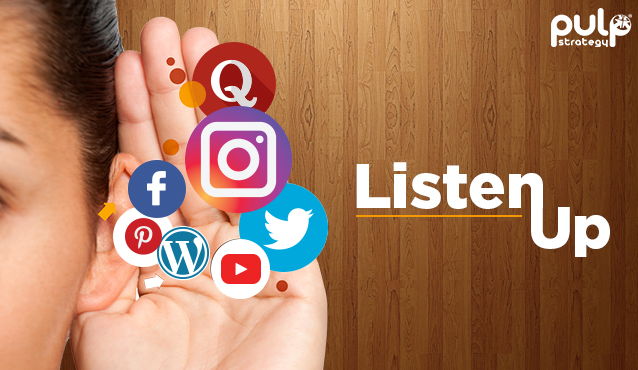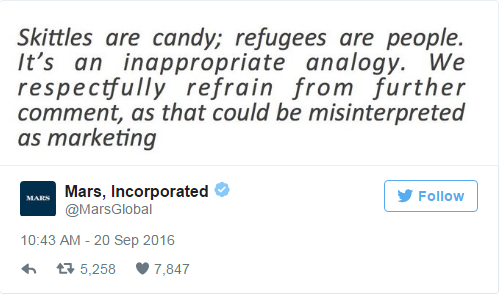'Your brand is what people say about you when you’re not in the room,' Jeff Bezos, Founder-Amazon.
Thanks to social media, consumers have the power to voice their opinions. And an opinion, if not attended to can turn into an upheaval. A popular campaign, a blockbuster movie, or a brand, no one can afford to turn a deaf ear on opinionated consumers/audiences armed with their social media handles and a parade of followers. With consumers turning savvy, brands, are also turning smart on social media, and defending themselves, sometimes with wisdom, sometimes with wit.
Welcome to 2017, where businesses ‘listen’.
The process of unbiased assessment of what is being said about a company, brand, topic or a person on social media channels can be termed as social listening.
A successful social listening needs to be proactive as well as reactive. Proactive listening is done by several forerunning brands to assess what’s worth their two pens.
- Is there a television series that is keeping people hooked, and is there a way they can grab mass attention by capitalizing on it?
Reactive listening, on the other hand, helps them keep a tab on consumer views about them.
- What is a general sentiment about their brand?
- Are they the talk of the town for good reasons or is there a jungle fire on their name?
Listening helps businesses avoid a burndown. Infact, there have been cases when timely listening and action has turned negative sentiments about a brand into an applaud.
Listen to manage crisis
Sentiments are communicable. A single negative comment can initiate an array of condemning comments all over social media, seriously affecting the brand reputation.
Brands that care about their consumers are taking out time each day to check what is being said about them online, responding to an appreciation with gratitude and attending to a criticism with an apology and rectification or a fitting (yet unoffensive) reply. In the world of social media, any response that isn’t immediate is too late.
Expedia is an ideal example of great proactive listening practice and smart conversion of sentiments. Sentiment analysis conducted by the brand revealed that the music played on the commercial had become incredibly irritating after multiple airings, and Twitteratis were brutally slating the music on social media. Rather than chalking up the advert as a failure, Expedia was able to address the negative sentiment in a sporting way by airing a new version of the advert which featured the offending violin being smashed.
Listen to plan your moves
The ability to extract insights from social data is a practice that is being widely adopted by organizations across the world. If you are planning content without knowing what your consumers want, then you are missing a huge piece of the jigsaw puzzle.
Social listening ensures you don’t miss out on opportunities to delight consumers or collect their valuable feedback. You might want to track the usernames of your competitors—their lack of social listening could mean a new customer for you.
Forerunning companies like Dell, have an inhouse listening team that work in tandem with the content team to develop content that serves as an answer to consumer queries on social media.
Why listening is the best art?
The average number of tweets going out per day is whopping 500 million. Stats say 30% of tweets mentioning your company don’t include your Twitter handle. This means there are conversations happening about you, behind you.
Make sure you’re tracking all the variations of your brand name, with and without the @symbol.
Now this doesn’t mean consumers are intentionally leaving you out of the conversation. Many a times, these customers are unaware about your official Twitter handle or sometimes have been a little lazy to exercise their fingers to track down your username. Whatever the reason is, consumers still expect a response.
Are you?
- Identifying influencers
Influencers are the key reason why companies practice social listening. Customers mostly trust peer recommendations before making a purchasing decision. With a big price placed on the opinion of another individual, it’s in company’s best interest to have influencers by your side. Engagement is the key to strengthen those relationships.
-
Looking for customer servicing opportunities
Social Media has doubled up as a complaint forum. Cosumers demand response and here is where most brands fail. Adding social listening to your strategy will help ensure that you don’t miss out on the opportunity to help existing customers or gain new ones.
-
Tracking a hashtag
Analyzing how well a campaign is doing? Don’t let those mentions go unheard. Because they are the metrics that analyze the sentiments of people on social media and tell how well your campaign is performing. This can even be used to stay up to date on potential issues your customers might encounter.
-
Analyzing competitors
Social media listening can give you insights what your competitors are upto. Tracking subjects of common interest and practicing proactive listening on keywords that matter to your industry can help you harness a trend faster and better than your competitors.
Social listening: PASS & FAIL!
Skittles, a well-known candy brand, has proved why social listening is important, for both good and bad reasons.
Skittles relaunched its product with a social media engagement idea so that customers could engage directly with the brand on their website. The official website of Skittles was converted into a Java panel over Twitter search with all tweets using the keyword ‘Skittles’ overflowing their website ticker. Though the user engagement plotted the graphs to a new high, but for all negative reasons. This experiment backfired badly; with vast majority of Skittles related posts were characterized more in terms of dismay than anything else.
Skittles failed in its social media campaign because all it did was hold a mirror up to conversations, without creating any value, and any rationale for productive engagement. If social listening was used, timely action could be taken to bring down the live Twitter panel or atleast moderate the tweets going on their website. Skittles could also have opted for a different approach so that they engage directly with their consumers rather than just setup a doorway to…… nothing.
But to err is to human, to learn from the error and bounce back is …well champion.
This time, Skittles rather than getting into a political mess, stayed sweet. Son of a certain presidential candidate linked Skittles to Syrian refugees. While many brands would like to stay away from political controversies, Skittles stepped up and acted like a boss. The social listening team identified that people were relating Skittles to Syrian refugees and made it clear that they did not support it and politely declined to comment on the issue. Tweets congratulating Skittles on a ‘pitch-perfect response’ flooded newsfeeds, and drove some to buy themselves a bag of the candy.
Netflix puts up a show:
House of Cards became an instant hit and busted down all the barriers to be nominated for an academy award. But what’s more interesting than the show itself is its making. Social listening played a huge part here to help analyze the audience preference and views on the storyline. Real-time listening and sentiment analyses on the show gave us one hell of a series. One thing Netflix does very well is that they analyze their audiences to their depths. In fact, every time you play, pause, fast forward, and stop a show through Netflix, it is recorded. This gave them tons of event data and predicted user behavior accurately.
The result? A near perfect customer profile which highlighted that Netflix audience prefers two main ingredients in their popcorn and Nachos. David Fincher and Kevin Spacey. And thus was born a show that kept people glued to their devices without even getting up to go to the washroom.
Sentiments are a big component of social media marketing. And the first step to managing sentiments is to listen. Brands that listen to the general opinion regularly, don’t need to firefight. Do you have a listening team in place?








